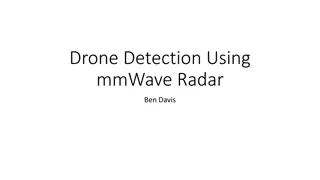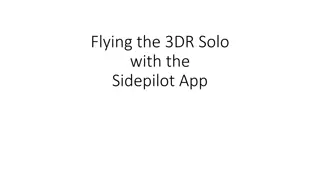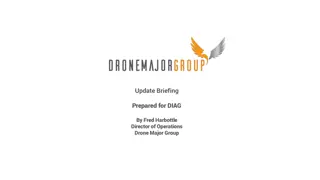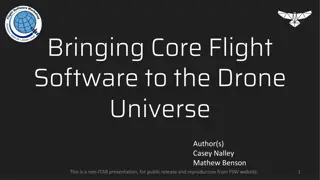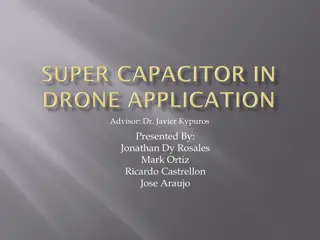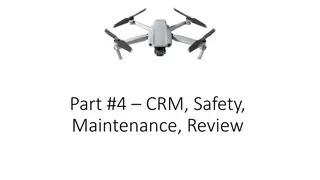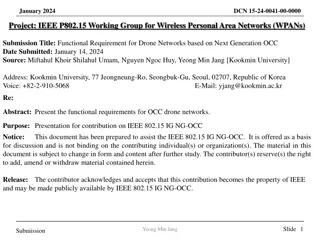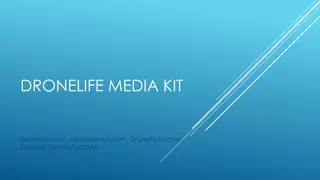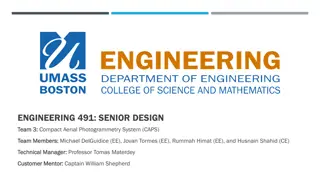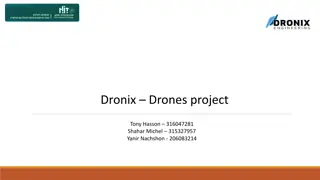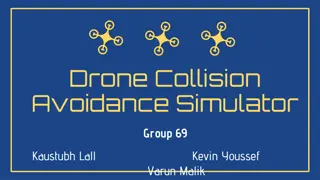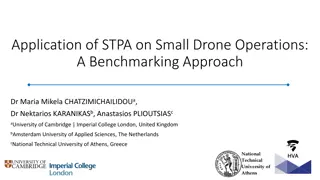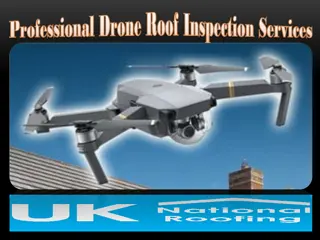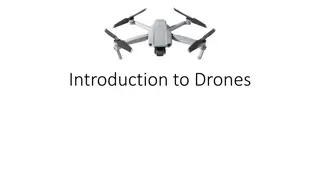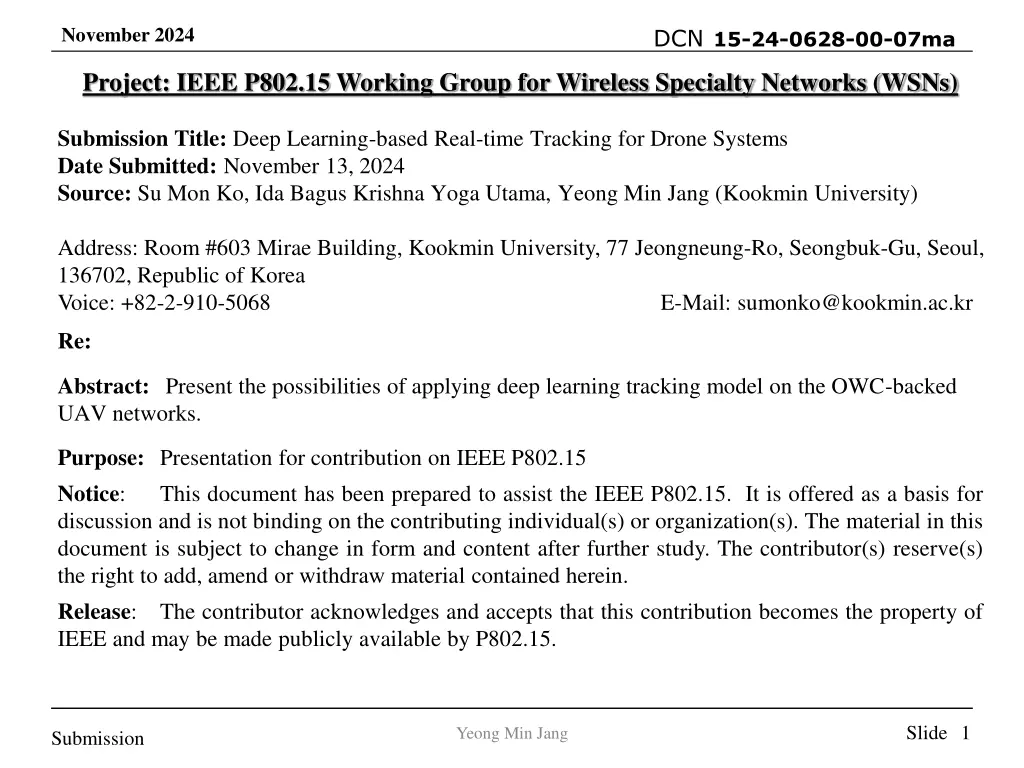
Real-time Tracking for Drone Systems: Deep Learning Application
Explore the application of deep learning tracking models on UAV networks backed by OWC technology. Enhance line-of-sight connections in high-mobility scenarios for effective communication. Learn about the current status, challenges, and future directions in this innovative field.
Download Presentation

Please find below an Image/Link to download the presentation.
The content on the website is provided AS IS for your information and personal use only. It may not be sold, licensed, or shared on other websites without obtaining consent from the author. If you encounter any issues during the download, it is possible that the publisher has removed the file from their server.
You are allowed to download the files provided on this website for personal or commercial use, subject to the condition that they are used lawfully. All files are the property of their respective owners.
The content on the website is provided AS IS for your information and personal use only. It may not be sold, licensed, or shared on other websites without obtaining consent from the author.
E N D
Presentation Transcript
November 2024 DCN 15-24-0628-00-07ma Project: IEEE P802.15 Working Group for Wireless Specialty Networks (WSNs) Submission Title: Deep Learning-based Real-time Tracking for Drone Systems Date Submitted: November 13, 2024 Source: Su Mon Ko, Ida Bagus Krishna Yoga Utama, Yeong Min Jang (Kookmin University) Address: Room #603 Mirae Building, Kookmin University, 77 Jeongneung-Ro, Seongbuk-Gu, Seoul, 136702, Republic of Korea Voice: +82-2-910-5068 E-Mail: sumonko@kookmin.ac.kr Re: Abstract: Present the possibilities of applying deep learning tracking model on the OWC-backed UAV networks. Purpose: Presentation for contribution on IEEE P802.15 Notice: This document has been prepared to assist the IEEE P802.15. It is offered as a basis for discussion and is not binding on the contributing individual(s) or organization(s). The material in this document is subject to change in form and content after further study. The contributor(s) reserve(s) the right to add, amend or withdraw material contained herein. Release: The contributor acknowledges and accepts that this contribution becomes the property of IEEE and may be made publicly available by P802.15. Slide 1 Yeong Min Jang Submission
November 2024 DCN 15-24-0628-00-07ma Deep Learning-based Real-time Tracking for Drone Systems November 12, 2024 Slide 2 Yeong Min Jang Submission
November 2024 DCN 15-24-0628-00-07ma Contents Background Current status Future direction Conclusion Slide 3 Yeong Min Jang Submission
November 2024 DCN 15-24-0628-00-07ma Background Utilizing optical wireless communication on the UAV networks allows for high transmission rate, low cost, and high flexibility [1]. UAV-assisted OWC networks supports the existing terrestrial network by providing a high mobility and flexible platforms for covering network blind spot or emergency use case. Because of using OWC technology, the communication between UAVs or ground-to-UAV requires a line-of-sight connection. However, maintaining a line-of-sight connection is difficult to establish due to the mobility of the UAVs. Hence, a pointing system that detect and tracks the OWC system is required to keep the line-of-sight connection and maintain the link between the UAVs or ground-to-UAVs. Slide 4 Yeong Min Jang Submission
November 2024 DCN 15-24-0628-00-07ma Current Status In [2], to enable the mobility in the OWC systems, a combination of photodiode (PD) and rolling shutter (RS) camera is proposed. A YOLOv5 model is developed to detect the location of the OWC transmitter where the input image is retrieved from the RS camera. Then, the PD with narrow field of view (FOV) is used for tracking the movement of the transmitter. Based on their results, the FOV is only 2 the mobility speed is only up to 0.4 m/s. Although already using deep learning for object detection, they still use a conventional method for tracking the transmitter, where the FOV and mobility speed is not suitable for UAV applications. Fig. 1: Configuration of real time object detection using YOLOv5 [2] Fig. 2: Configuration of PD and camera for real time tracking[2] Slide 5 Yeong Min Jang Submission
November 2024 DCN 15-24-0628-00-07ma Current Status A combination of YOLOv8 and conventional tracking mechanism is also proposed in [3]. Two-steps process is employed where the region of interest (RoI) resulted from YOLOv8 is fed to the conventional tracking algorithm to continuously track the transmitter image between frames. They implement it in indoor environment with distance between 1-5 m and sampling rate of 30 Hz. A fully YOLO-based for transmitter tracking is proposed in [4] where they use only YOLO model for detecting and tracking the transmitter. The experiment is performed in indoor environment where it results in rotation-invariant detection. Existing tracking algorithm like DeepSort or ByteTrack also can be combined with object detection model for tracking the OWC transmitter. Fig. 3: Hybrid OpenCV tracker and YOLOv8 for OWC transmitter detection [ref rangga] Fig. 3: Symbol detection and tracking using YOLO [ref aql] Slide 6 Yeong Min Jang Submission
November 2024 DCN 15-24-0628-00-07ma Future Direction of Tracking the OWC Transmitter 1. Use Vision Transformer-based deep learning model As shown in [5,6], the ViT-based model achieve significant improvement compared to other deep learning-based model (CNN, RPN, etc) For UAV tracking performance, using ViT-based model can achieve more than 85.9% precision and up to 185 FPS. By using ViT-based model, the deep learning model complexity is significantly reduced, compared to the CNN-based model. 2. All-in-one detection and tracking model Currently, the tracking model always depends on another model as the object detection model. The object detection model acts to extract the RoI of the OWC transmitter, then the tracking model will perform the tracking based on the RoI input. Using two models increase the complexity of the systems and reduce the overall performance. Especially for UAV applications, high complexity consumes more energy which reduce the flight time. Hence, using an all-in-one model using ViT may improve the system performance as well as efficiency. Slide 7 Yeong Min Jang Submission
November 2024 DCN 15-24-0628-00-07ma Future Direction of Tracking 3. Develop ViT model for small object detection and tracking For implementation in UAV-assisted OWC networks, due to the mobility of the UAV, the transmitter is seen small from distance. Meanwhile, the current ViT model is not optimized for small object detection and tracking. As such, developing a ViT-based model for small object detection and tracking enable the applications in UAV-assisted OWC networks to maintain the link. Slide 8 Yeong Min Jang Submission
November 2024 DCN 15-24-0628-00-07ma Conclusion In the UAV-assisted OWC networks, detecting and tracking the transmitter is important to maintain the link during data transmission. Existing methods are only in experimental stage where the FOV, mobility speed, and distance is limited. The usage of ViT-based model for detection and tracking is proved to be more efficient than other deep learning method. The development of ViT-based model for small object detection and tracking allows the possibility to implement the model in UAV system which improve the OWC performance by helping to maintain the link during transmission. Slide 9 Yeong Min Jang Submission
November 2024 DCN 15-24-0628-00-07ma References [1] Y. Li et al., "Sensing Assisted Optical Wireless Communication for UAVs," in IEEE Transactions on Vehicular Technology, doi: 10.1109/TVT.2024.3426588. [2] S. Araki, Y. Imagawa, H. Uchida, W. Chujo and K. Kobayashi, "Tracking an LED Transmitter by a Photodiode Receiver Using Object Detection with a Rolling Shutter Camera," 2024 IEEE 99th Vehicular Technology Conference (VTC2024-Spring), Singapore, Singapore, 2024, pp. 1-5, doi: 10.1109/VTC2024-Spring62846.2024.10683531. [3] Nasution, M.R.A.; Herfandi, H.; Sitanggang, O.S.; Nguyen, H.; Jang, Y.M. Proximity-Based Optical Camera Communication with Multiple Transmitters Using Deep Learning. Sensors 2024, 24, 702. https://doi.org/10.3390/s24020702. [4] Y. Sasaki, K. Maruta, S. Kojima, D. Hisano and Y. Nakayama, "Light Source Tracking System for A-QL based Display-Camera Communication," 2023 IEEE 97th Vehicular Technology Conference (VTC2023-Spring), Florence, Italy, 2023, pp. 1-6, doi: 10.1109/VTC2023- Spring57618.2023.10200481. [5] S. Li, Y. Yang, D. Zeng and X. Wang, "Adaptive and Background-Aware Vision Transformer for Real-Time UAV Tracking," 2023 IEEE/CVF International Conference on Computer Vision (ICCV), Paris, France, 2023, pp. 13943-13954, doi: 10.1109/ICCV51070.2023.01286. [6] B. Kang, X. Chen, D. Wang, H. Peng and H. Lu, "Exploring Lightweight Hierarchical Vision Transformers for Efficient Visual Tracking," 2023 IEEE/CVF International Conference on Computer Vision (ICCV), Paris, France, 10.1109/ICCV51070.2023.00881. 2023, pp. 9578-9587, doi: Slide10 Yeong Min Jang Submission



